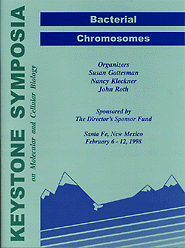The Achaeal Chromosomes: Diverse Patterns of
DNA Topology and Topoisomerases Activities
Patrick Forterre, Purificacion Lopez-Garcia, Olivier Guipaud, Danièle
Gadelle and Agnes Bergerat
Institut de Génétique et Microbiologie, Université
Paris-Sud, CNRS URA 1354, 91405 Orsay Cedex, France.
The archaeal chromosomes resemble bacterial ones in size and organisation.
However, at the molecular level, they exibit a mixture of eucaryal and bacterial
features. For example, some Archaea contain HU-like proteins, whilst others
have true homologues of eucaryal histones. Archaea posses homologues of
eucaryotic replication and repair proteins, but also of bacterial genes
involved in SOS repair or cell division (FtsZ, MinD) (for review see ref.1).
An interesting aspect of archaeal chromosome is their diverse topological
structures (2). Mesophilic archaea have negatively supercoiled DNA whilst
thermophilic ones have relaxed or positively supercoiled DNA (3). In halophiles,
negative supercoiling can be correlated to the presence of a classical gyrase,
whilst in some hyperthermophiles, positive supercoiling can be correlated
to the presence of reverse gyrase. However, the hyperthermophilic bacterion
Thermotoga that contains both a gyrase and a reverse gyrase harbour a negatively
supercoiled plasmid (4), suggesting that presence or absence of gyrase is
the main determinant of supercoiling in procaryotic chromosomes. Interestingly,
archaea contain a novel kind of type II DNA topoisomerase, Topo VI (5).
This archaeal enzyme is an heterotetramer whose one subunit belongs to a
newly identified ATPase superfamily whilst the other is an homologue of
the protein which initiates genetic recombination in eucaryotes (5). Further
comparison between archaeal and bacterial chromosomes should help to understand
early cellular evolution as well as the problem of eucaryote origin.
- 1 Forterre, P. Curr. Opin. Gen. Dev. in press.
- 2 Forterre, P., et al. .FEMS Microbiol. Rev. 18, 237-247 (1996).
- 3 Lopez-Garcia, P and Forterre, P Mol. Microbiol. 23, 1267-1279, (1997),
- 4 Guipaud, O., et al. Proc. Natl. Acad. Sci. 94, in press, (1997),
5 Bergerat, A. et al., P. Nature, 386, 414-417 (1997)
|

















